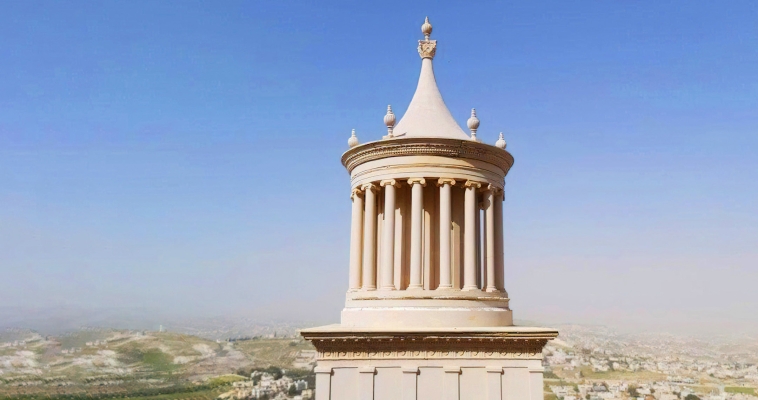Herodium – The Mountain Herod Built
Text and photos by Lydia Aisenberg
Towering above a large swath of the semi-arid Judean desert, surrounded by sprawling Palestinian villages and with the outskirts of Jerusalem clearly visible in the near distance, the majestic Herodium sits at 758 meters (2,487 feet) above sea level. It is one of the most unique and impressive building complexes constructed during the first century BCE by Herod, the vassal king appointed by the Romans in 40 B.C.E. to rule over Judea on their behalf.
Although living in Israel for over 50 years, I only recently visited the Israel Nature and Parks Authority's Herodium complex for the very first time. My previous planned visits had been thwarted on numerous occasions because of security concerns at the time in that particular area.
Herodium is considered to be one of the most important and ultra-ambitious building sites of the ancient world. It was originally intended to commemorate the ruthlessly driven King Herod's life and work, particularly those colossal, mind-boggling building projects undertaken by him throughout Judea.
It is indeed a truly spectacular place, with history literally oozing out of every rock, pathway, umpteen flights of narrow and wide stone stairways, and buildings large and small. On a clear day its breathtaking vistas offer a visual, pulsatingly awesome geographical map on high of the Judean desert as it sweeps down toward the Dead Sea … and beyond.
As one leaves the ticket office and visitors' center to begin viewing the umpteen wow-factor aspects of Herodium, one is greeted by a large stack of almost round, very heavy and ominous-looking rocks surrounded by a metal fence. Mounted on two none-too-friendly-looking replica long spears, a metal sign attached reads: "Rolling Stones from the time of the Jewish Revolts against the Romans." This gave rise to a number of witty remarks from visitors referring to the eponymous 1960s British rock band, and others adding quips about the Beatles being somewhere under the pile of Stones.
Herod's ambitious original plans for Herodium included an enormous complex of palaces, a heavily fortified hilltop fortress looming over the region from above, an impressive theater, a mausoleum, an administrative compound and a then state-of-the-art recreation center, and so much more. All these would have outdone any similar structures already existing within the Roman world up until then – had it been completed, that is.
With the king's health rapidly failing, the would-be wonder of the Roman world and beyond instead became a massive burial site and monument of gigantic proportions. Most of what had already been achieved until his imminent demise was filled in and covered up, thus becoming a gigantic man-made hill or mini-mountain, visible from great distances.
Present day visitors to the Israel Nature and Parks Authority's Herodium Park receive a detailed map, full of interesting text, diagrams and photographs. These help one to better understand, and certainly even more appreciate, the enormity of Herod's project, particularly the absolute professionalism and monumental efforts of the architects, builders, stonemasons, plasterers, artisans and laborers.
Particularly impressive is the 400-seat open-air but intimate amphi-style theater's seating and stage, all of which are tucked under a wide balcony that leads to the enclosed private chamber intended for Herod and his chosen guests. Inside the chamber is an array of miraculously preserved paintings, including those of extremely believable marble pillars and columns, imaginary windows offering imaginary views of countryside, fauna, flora and animals, as well as artistically created framed pictures. A nail and string are also painted on the wall, as if the paintings are actually hanging.
Herodium was first identified in 1838 by Edward Robinson, an American explorer. Some 40 years later the German architect, archaeologist and Protestant missionary who had settled in Jerusalem, Conrad Schick, described the site in depth and also drew a detailed map.
Schick (1822-1901) headed an institution at the Anglican Christ Church, known as the House of Industry, a vocational training center belonging to the London Society for Promoting Christianity Amongst the Jews – and it was the multi-talented architect-missionary Schick who was chosen to design Mea Shearim, one of the first Jewish neighborhoods to be constructed outside the Old City walls.
In 1962, Father Virgilio Corbo, a Franciscan Friar and professor of archaeology, was the first to begin excavating the site, and until 1967 was successful in revealing a sizeable portion of the upper parts of Herodium. After the Arab-Israel war of 1967 the Hebrew University took over the excavations, first directed by Prof. Gideon Foerster and followed in 1972 by Prof. Ehud Netzer of the Hebrew University's Institute of Archaeology, who also initiated, planned and led the development of the current incredible national park at the site.
Netzer was a world-renowned scholar of Herod's architecture who had been involved in excavations of many famous sites, such as Masada, Jericho, Caesarea and Sepphoris. He is also well-known for his important research on palaces in the Classical world, synagogues, the Jerusalem Temple, Nabatean burial architecture and far more.
In 2010, whilst working at the site of the theater at Herodium, situated relatively close to Herod's tomb, Professor Netzer was gravely injured following a fall caused by a railing collapse and died a few days later in Jerusalem's Hadassah hospital.
The enormity of Herodium is mind-boggling both in physical and historical terms, with so many incredible physical features, plus the underground network of tunnels and cisterns, and of course Herod's tomb itself. A fascinating and challenging site to visit.








Comments